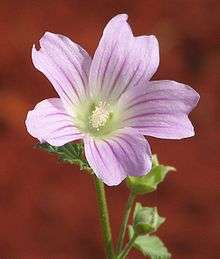Malva preissiana
Malva preissiana, the Australian hollyhock or native hollyhock, is a herbaceous perennial in the family Malvaceae, found in all Australian states.[1][3][4]
| Malva preissiana | |
|---|---|
 | |
| Australian hollyhock | |
| Scientific classification | |
| Kingdom: | Plantae |
| Clade: | Tracheophytes |
| Clade: | Angiosperms |
| Clade: | Eudicots |
| Clade: | Rosids |
| Order: | Malvales |
| Family: | Malvaceae |
| Genus: | Malva |
| Species: | M. preissiana |
| Binomial name | |
| Malva preissiana | |
 | |
| Occurrence data from AVH | |
| Synonyms[1] | |
| |
It is a large herb, growing up to 3 metres high and up to 3 metres wide, depending on the number of stalks or branches, that the bush has. It is a short lived perennial living around 3–5 years.
The plant was once common on the banks of waterways in Southern Australia, especially those on the plain where the city of Adelaide now stands. It was greatly admired by the early settlers of the Adelaide region as it reminded them of the hollyhocks back in their home country of England. This did not stop them destroying most of the areas where Native hollyhock occurred, and today it is a rare species. It still occurs in small populations on the banks of the River Torrens. Recently it has also been included in several revegetation projects in parks across the city.
The leaves are hairy and typical of most mallows. They have five pointed lobes, and large prominent veins.[5] In spring, native hollyhock breaks out into masses of large showy flowers. This makes it an extremely ecologically valuable plant for the local bees and butterflies. Flowers range in colour from the common white, to pale pink and mauve. The flowers have five petals which tinge slightly yellow as they reach the centre of the flower. The flowers die back in early summer to reveal a small cup shaped fruit containing clusters of small black seeds with unusual shapes. During summer the plant dies down and goes into a period of little or no growth until the rains arrive in autumn.
Human uses
The plants large, tuberous root, has important medicinal properties, and was also mashed and eaten by the local aboriginal people. Native hollyhock is easily propagated from its complex black seeds.
References
- "Malva preissiana". Australian Plant Name Index (APNI), IBIS database. Centre for Plant Biodiversity Research, Australian Government.
- Miquel, F.A.W. in Lehmann, J.G.C. (ed.) (1845), Malvaceae. Plantae Preissianae 1(2): 238
- Australasian Virtual Herbarium: Malva preissiana. Retrieved 22 October 2018.
- Govaerts, R. et. al. (2018) Plants of the world online:Malva preissiana. Board of Trustees of the Royal Botanic Gardens, Kew. Retrieved 22 October 2018.
- "Lavatera plebeia". Electronic Flora of South Australia Fact Sheet. State Herbarium of South Australia. Archived from the original on 7 February 2012. Retrieved 1 February 2008.
External links
- VicFlora: Malva preissiana
- NT Flora factsheet: Malva preissiana
- PlantNet: Malva preissiana Royal Botanic Garden, Sydney.
- Florabase: Malva preissiana